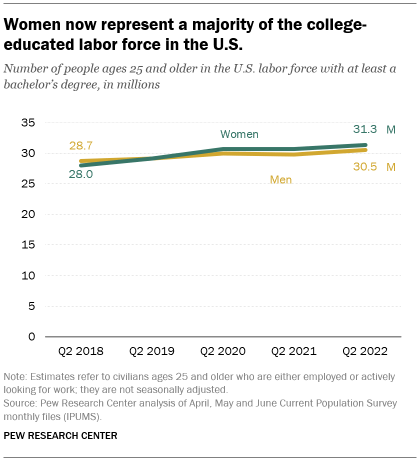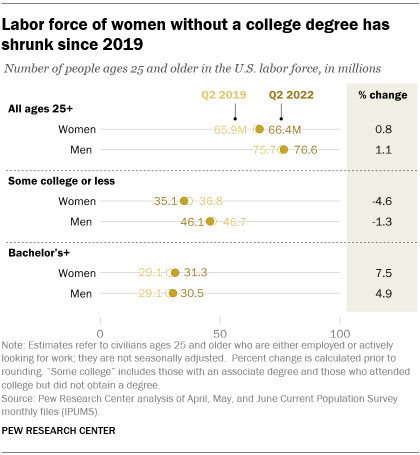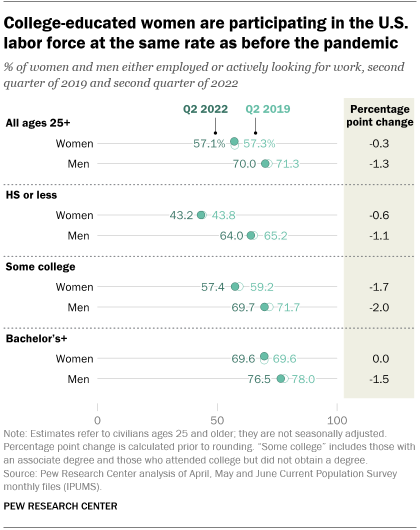
Women have overtaken men and now account for more than half (50.7%) of the college-educated labor force in the United States, according to a Pew Research Center analysis of government data. The change occurred in the fourth quarter of 2019 and remains the case today, even though the COVID-19 pandemic resulted in a sharp recession and an overall decline in the size of the nation’s labor force.

Today, there are more women ages 25 and older with a bachelor’s degree or more education in the labor force than before the pandemic: 31.3 million in the second quarter of 2022, compared with 29.1 million in the same quarter of 2019. The number of college-educated men ages 25 and older in the labor force is also greater than before the pandemic – 30.5 million, up from 29.1 million – though their ranks have not increased as quickly as those of women.
In 2019, women were on the cusp of overtaking men in the ranks of the college-educated labor force. The COVID-19 recession resulted in millions of Americans leaving the workforce, but it had disparate impacts on men and women, as well as on different industries and occupations. Two years into the recovery, Pew Research Center conducted this analysis to assess the progress of women toward the milestone of becoming a majority of the college-educated labor force.
Labor force estimates and participation rates are derived from the Current Population Survey (CPS) monthly files, sponsored jointly by the U.S. Census Bureau and the U.S. Bureau of Labor Statistics. The CPS is the nation’s premier labor force survey and is the basis for the monthly national unemployment rate released on the first Friday of each month. The CPS is based on a sample survey of about 60,000 households. The estimates are not seasonally adjusted.
The CPS microdata files analyzed were provided by the Integrated Public Use Microdata Series (IPUMS) at the University of Minnesota.
The COVID-19 outbreak affected data collection efforts by the U.S. government in its surveys, especially in 2020 and 2021, limiting in-person data collection and affecting the response rate. It is possible that some measures of labor market activity and how they vary across demographic groups are affected by these changes in data collection.
The pandemic disproportionately impacted labor market activity for adults without a bachelor’s degree, especially among women. The number of women with some college or less education in the labor force has declined 4.6% since the second quarter of 2019, compared with a smaller change among men with some college or less education (-1.3%).

The upshot of these disparate changes in the labor force by gender and education is that women have increased their representation in the college-educated labor force since 2019. At the same time, there has not been much change in the gender composition of the labor force that has some college or less education.
Changes in the composition of the U.S. population, along with changes in labor force participation, help account for these trends. The number of women and men in the labor force depends on the size of each group and the percent of that group who are working or seeking work.
The number of women and men in the U.S. with at least a bachelor’s degree has increased since the second quarter of 2019. But the share of college-educated women who are in the labor force has not changed since before the pandemic, while the share of college-educated men who are working or looking for work has declined.

In the second quarter of 2022, the labor force participation rate for college-educated women was 69.6%, the same as in the second quarter of 2019. In contrast, men and most other educational groups now have lower rates of labor force participation than they did in the second quarter of 2019.
This shift in the college-educated labor force – as women now comprise a majority – comes around four decades after women surpassed men in the number of Americans earning a bachelor’s degree each year.
